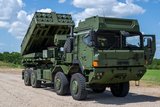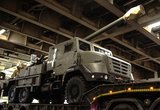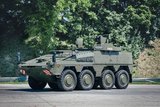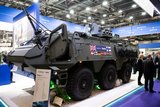Turkey tests new Multi-Barrel Rocket Launcher
The 107mm Multi-Barrel Rocket Launcher has been developed by Roketsan and MKEK. (Photo: SavunmaSanayiST)
Turkey has successfully integrated the 107mm Multi-Barrel Rocket Launcher onto its BMC-produced VURAN vehicle and tested its firing capabilities.
The rocket launcher has been developed by Roketsan and MKEK.
The Multi-Barrel Rocket Launcher successfully hit the target in a test firing, proving its firing capabilities.
The VURAN Multi-Barrel Rocket Launcher Vehicle can fire 12 107mm rockets in a single set and has a high degree of mobility.
The 107mm rockets used by the launcher have a maximum range of 11km, a weight of 20kg and an impact diameter of about 15m of warheads.
The Turkish Ministry of National Defence supplied one VUR Multi-Barrel Rocket Launcher Vehicle to the Army Command for trial purposes.
According to Shephard Defence Insight, the VURAN was developed as a private venture to fulfil a range of roles, including APC and weapons carrier.
It features a V-shaped mine-protected hull with sufficient room to accommodate nine personnel and their equipment.
Additionally, it can be fitted with an RWS, EO/IR sensors and communications systems to meet different mission requirements.
Related Equipment in Defence Insight
More from Land Warfare
-
![Light Reconnaissance Strike – enabling a vital mission set (Studio)]()
Light Reconnaissance Strike – enabling a vital mission set (Studio)
A new system-of-systems concept will unlock digital integration of sensors and weapons for Light Forces, allowing them to shape the battlefield environment on their own terms and upgrade legacy platforms.
-
![Lockheed Martin to look further afield for GMARS rocket system opportunities]()
Lockheed Martin to look further afield for GMARS rocket system opportunities
The HX truck is already in use in many NATO and allied countries around the world as a logistics vehicle and carrier for high-value systems, including missile firing weapons, so its use for the Global Mobile Artillery Rocket System makes logistical sense.
-
![Lithuanian 1st Division to achieve initial operating capability in 2026]()
Lithuanian 1st Division to achieve initial operating capability in 2026
Lithuania is one of the countries stepping up its defences in the face of the war in Ukraine with a particular focus on its neighbour and Russian ally Belarus, which has been making incursions into Lithuania’s airspace with balloons and drones.
-
![Beyond Survivability: How Active Protection Systems Are Empowering Commanders (Podcast)]()
Beyond Survivability: How Active Protection Systems Are Empowering Commanders (Podcast)
As threats diversify and intensify, APS are proving essential not just for vehicle protection but also for enhancing operational freedom, effectiveness and mission success in contested environments.
-
Medium knocked out of British Army LMP, with CAVS as heavyweight champion
As the British Army seeks to modernise and consolidate its diverse vehicle fleet, yet another change in direction is underway.


























